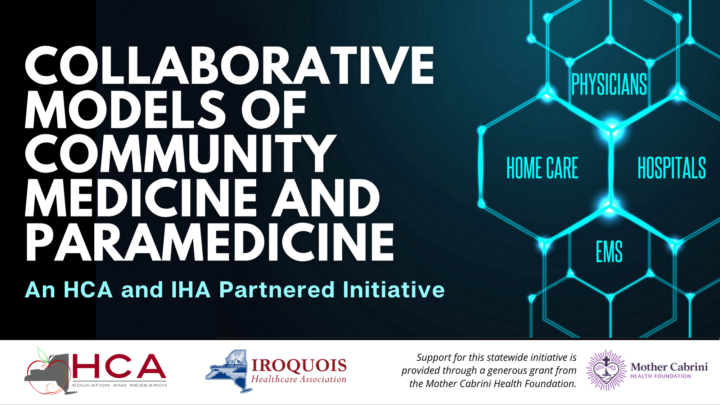
About
The Home Care Association of New York State (HCANYS), the Iroquois Healthcare Association (IHA), and IPRO, the state-federal regional quality improvement organization, partnered to develop and pilot Collaborative Models of Community Medicine and Paramedicine. This initiative involves a multiyear plan that is currently underway in five rural and small community regions that have developed pilots across New York State: Jefferson, Broome, Columbia and Greene, St. Lawrence, and Tompkins and Schuyler counties. Core health sector partners and practitioners from local hospitals, home health agencies, physicians, and emergency medical service organizations are working together to develop and implement collaborative models to strengthen care in their communities. Health sectors and health personnel must function together to make a collaborative, integrative program of this nature work.
Community and System Need
Coordinating and optimizing the roles of all core partners in the delivery of care, particularly amid growing care complexity and shortage of resources, is critical to patient access, quality, and outcomes. The need for a coordinated response is exacerbated by the chronic and worsening health personnel shortages in the NYS healthcare system that impair access and continuity of care for medically, socio-economically, and mentally vulnerable individuals living in the community. Coverage and regulatory gaps in the healthcare system have severe consequences on individuals, the community, and priority public health concerns.
A key direction is the development and promotion of collaborative care by hospitals, physicians, home health agencies, and core community partners like EMS. While emergency care is traditionally the focus for paramedics and EMTs, they can play further invaluable roles in the overall system, and in partnership with patients’ care teams. They are frequently called into non-urgent medical situations, but in their current role are constrained to emergency response. This puts a burden on emergency care teams and threatens to harm those in true need of urgent or emergency care. By leveraging collaboration between emergency services and other health sector partners, this burden can be reduced while also ensuring patients receive appropriate and efficient care.
The Models
Traditionally, developing programs of community medicine in NYS that include elements of paramedicine is a challenge. Instead of focusing solely on statutory change, this initiative draws upon collaboration. This program is highly community-centered and requires consistent collaboration among providers. When providers collaborate and work together towards common goals, healthy communities are built.
Collaborative models aim to optimize resources and work with all key players towards goals to support care transitions, continuity of patient service, and coordinated intervention in vulnerable periods or vulnerable populations. The goal is to avoid ED episodes and visits, reduce hospital readmissions, and avoid unnecessary hospitalizations and unnecessary ambulance transports. The pilots share similar goals, but each is tailored to the available community resources and the identified needs of the individuals living in each respective community.
The Jefferson County Pilot has started a successful effort to provide care across the hospital and home care spectrum. The foundation of the success thus far is attributable to continued education, communication, and trust-building across all core partners. Learn more about this model by watching the February 10, 2023 webinar, “Jefferson County Mobile Integrated Health: A Blueprint for Collaboration” here.
Related Resources
Community Paramedicine Program Protocol Research
Project Scope of Activity Descriptions
Jefferson County Blueprint Narrative Description
HCA Innovations in Spotlight at NAHC Home Care and Hospice Conference
Thank you to the generous support from Mother Cabrini Health Foundation for making this initiative possible.



